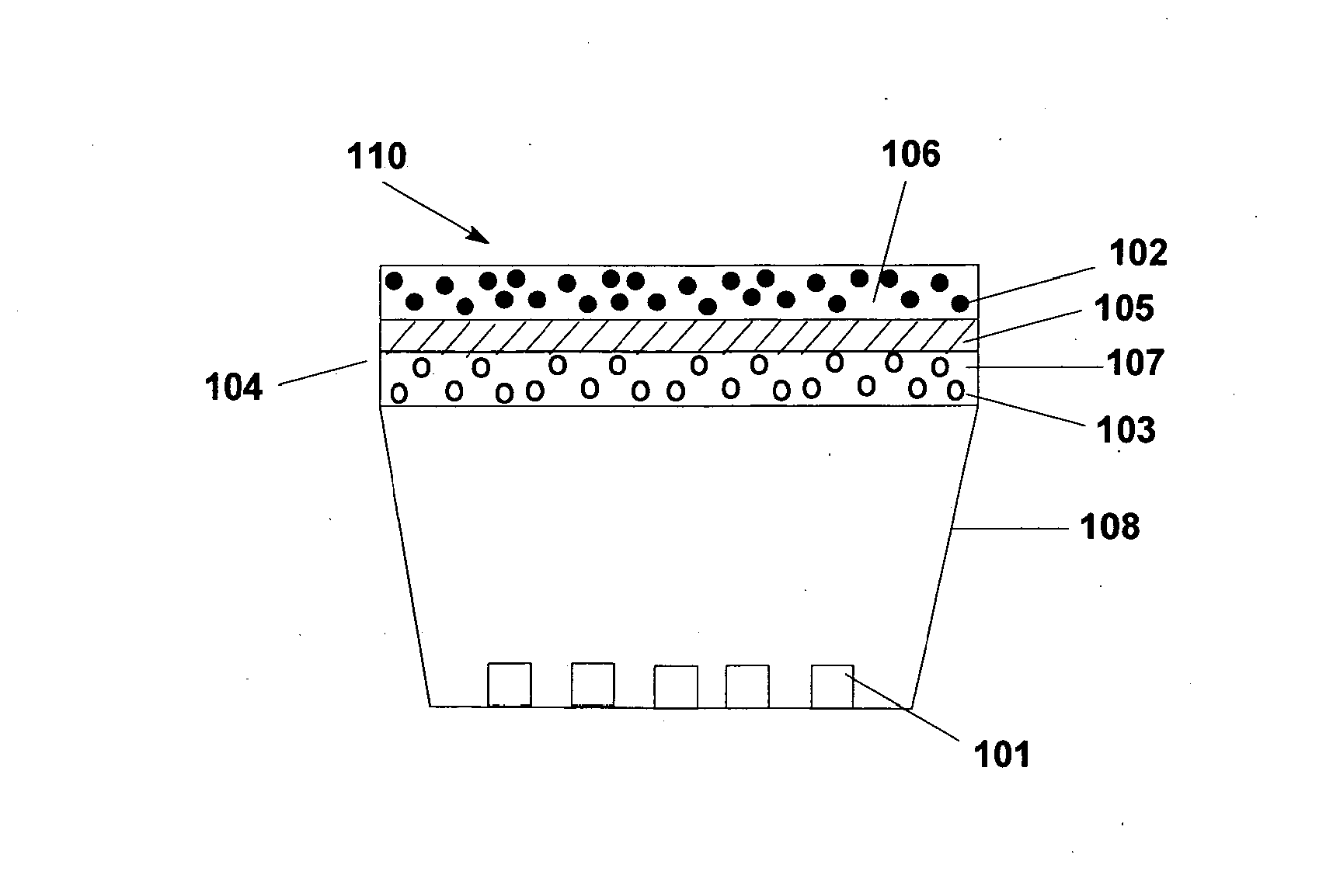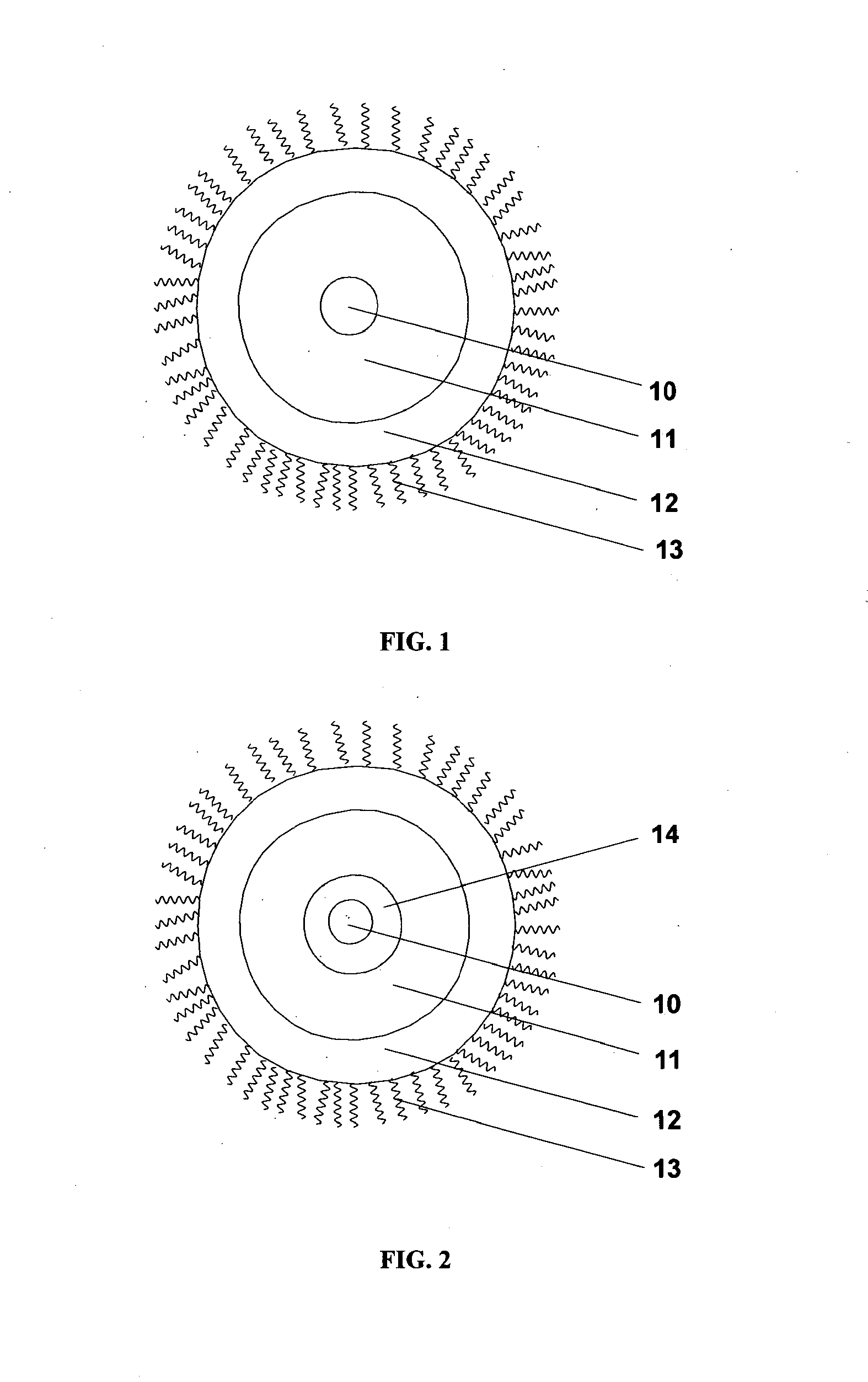White light emitting device
a light-emitting device and white light technology, applied in the direction of semiconductor devices for light sources, light and heating apparatus, sustainable buildings, etc., can solve the problems of significant lattice mismatch, limited color possibilities of conventional led's, and difficulty in achieving the desired emission properties and absorption properties of semiconductor nanocrystals, etc., to achieve reduced reabsorption energy transfer, reduce quenching, and reduce the effect of unwanted quenching
- Summary
- Abstract
- Description
- Claims
- Application Information
AI Technical Summary
Benefits of technology
Problems solved by technology
Method used
Image
Examples
example 1
Synthesis of LR Quantum Dots
Preparation of Reaction Solutions
[0099]Materials: Technical grade (90%) Octadecene (ODE), Indium acetate (In(Ac)3, 99.99%), Tri-n-octylphosphine (TOP, 97%), Stearic acid (SA, 98%), oleic acid (90%), Zinc stearate (ZnO 12.5-14%), Tris-trimethylsily phosphine (P(TMS)3, 95%) 1-octylamine (99%) were purchased from Alfa. Oleylamine (97%) and octadecylamine (ODA, 97%) were purchased from Aldrich. Copper stearate was prepared by well-known methods. All the chemicals were used without further purification.
Precursor Solutions
0.1M Cd Solution:
[0100]CdO (1.28 g) and 22.5 g OA (oleic acid) and 65.0 g ODE (1-Octadecene) were placed in a 250 ml round bottom flask. The mixture was heated to 250° C. under argon flow until clear. The solution was allowed to cool to room temperature and the reaction mixture was stored at room temperature. When needed, this mixture was re-heated to afford a clear solution, referred to below as the Cd solution.
0.1M Zn Solution:
[0101]ZnO (1.2...
example 4
Modeling Light Absorption, Emission, and Reabsorption
General Procedure
[0117]Representative optical density D(λ) spectra, emission E(λ) spectra, and emission quantum yields (QY) for LR quantum dots and conventional quantum dots were determined experimentally. The power spectrum of a typical 450-nm diode was converted to photons via the relationship: Io(λ)=0.5035×1016*P(λ)*λ. Quantum dot emission spectra were normalized according to the equation: Etotal=∫(λ)dλ and Eo(λ)=E(λ) / Etotal. Absorbed photons were calculated from the equation: T(1)=10−D(λ), A(λ)=1−T, and IA(λ)=Io(λ)*A(λ). The total number of absorbed photons is given by: IAtotal=∫IA(λ)dλ. The initial emission spectrum resulting from the LED exposure is then given by the equation: E(λ)initial=IAtotal*QY*Eo(λ). However, a portion of this emission is re-absorbed by the dots according to: E(λ)reabs1=E(λ)initial* A(λ). The ‘net’ emission is given by: E(λ)net1=E(λ)initial−E(λ)reabs1. However this relationship overestimates re-absorpt...
example 5
White Light-Emitting Device
[0122]A light source (LED chip) having an emission wavelength of 455 nm was die attached to a regular silver coated Cu substrate. Wire bonding using gold wires 0.032 mm (1.25 mil) in diameter was employed to make the electrical connection between the electrodes of the light source and the substrate. A silicate phosphor (Internatix G2762, having a particle size of about 15 microns) with an emission wavelength of 525 nm was mixed with Dow Corning silicone kit using a ratio of phosphor: part A: part B of 0.9:0.8:1.6 by weight. The mixture was coated on top of the LED light source and then cured at 150° C. for one hour. LR quantum dots having an emission maximum at a wavelength of 609 nm were mixed with polymer (1 g of mercapto functionalized ester, which is a clear, colorless, liquid photopolymer that will cure when exposed to ultraviolet light) and the mixture was dispensed on top of a round shaped polycarbonate lens and then exposed to UV light and cured fo...
PUM
 Login to View More
Login to View More Abstract
Description
Claims
Application Information
 Login to View More
Login to View More - R&D
- Intellectual Property
- Life Sciences
- Materials
- Tech Scout
- Unparalleled Data Quality
- Higher Quality Content
- 60% Fewer Hallucinations
Browse by: Latest US Patents, China's latest patents, Technical Efficacy Thesaurus, Application Domain, Technology Topic, Popular Technical Reports.
© 2025 PatSnap. All rights reserved.Legal|Privacy policy|Modern Slavery Act Transparency Statement|Sitemap|About US| Contact US: help@patsnap.com



